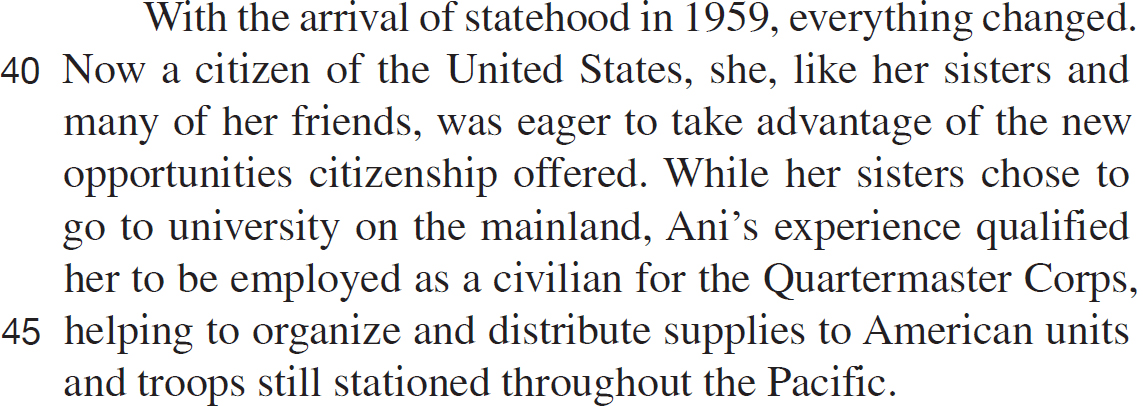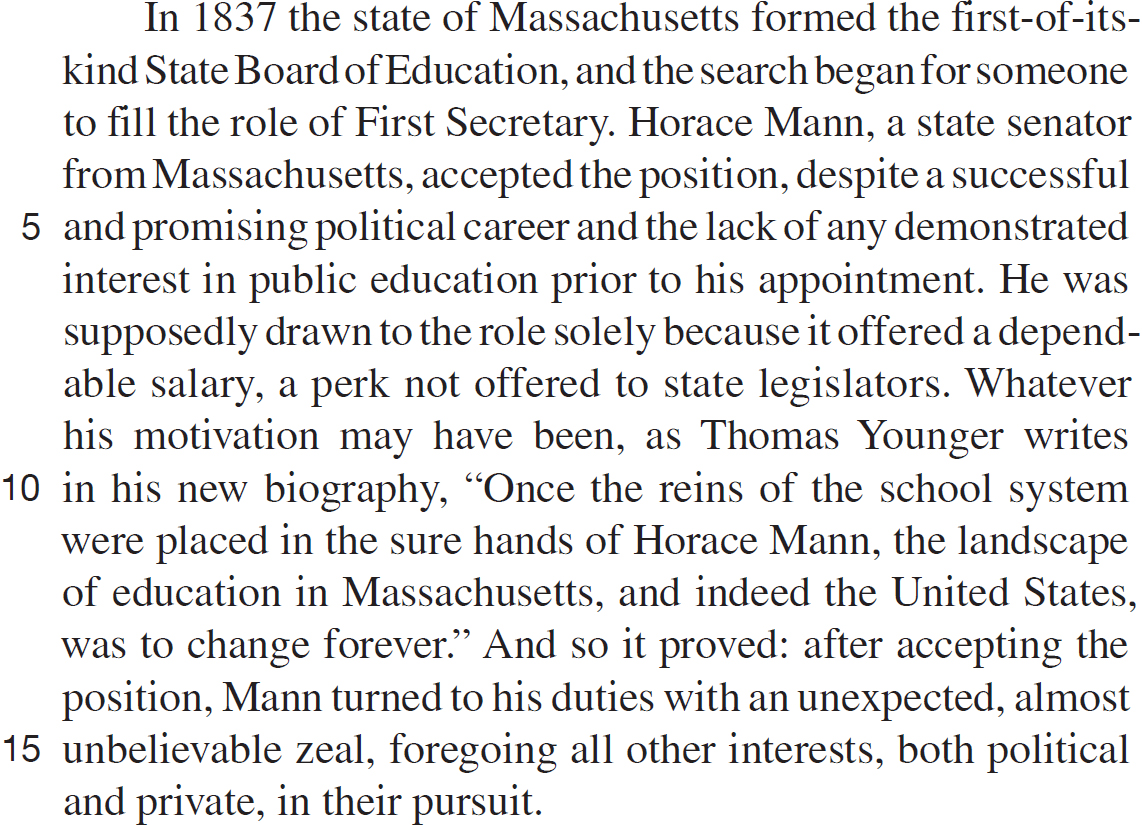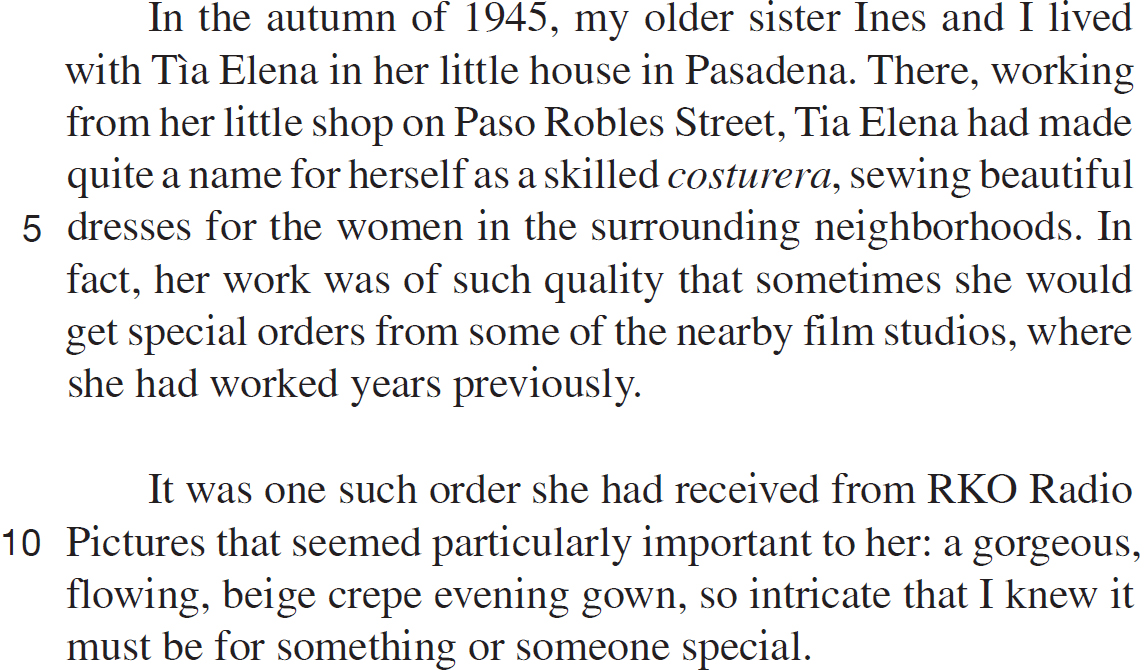Chapter 17
Reading Practice Test 4
Click here to download a PDF of Reading Practice Test 4.

READING TEST
35 Minutes—40 Questions
DIRECTIONS: There are four passages in this test. Each passage is followed by several questions. After reading each passage, choose the best answer to each question and blacken the corresponding oval on your answer document. You may refer to the passages as often as necessary.
Passage I
PROSE FICTION: This passage is adapted from the novel Birds of Paradise by Minnie Foroozan (©2002 by Minnie Foroozan).






1. The events in the passage are described primarily from the point of view of a narrator who presents the:
A. thoughts of Kealoha, her customers, and her family as conveyed in dialogue.
B. inner thoughts and sentiments of Kealoha only.
C. inner thoughts of Kealoha and Santos only.
D. inner thoughts and emotions of all the people in Kealoha’s life.
2. The passage supports all of the following statements about the Moana Hotel EXCEPT that:
F. it was one of the better-known hotels on the island of O’ahu.
G. Kealoha worked there as a chambermaid.
H. it had more rooms than the hotel Kealoha currently owns.
J. its guests included celebrities as well as people who were not as well-known.
3. Which of the following questions is NOT answered by the passage?
A. What kind of business did Kealoha’s parents own?
B. How long did Santos live in the Philippines before moving to Tacoma?
C. How did Pup react when Kealoha and Santos listened to the radio?
D. Under what circumstances did Kealoha first become aware of Santos?
4. One of the main ideas of the second paragraph (lines 15–31) is that:
F. as a young woman, Kealoha often changed jobs because she quickly grew bored at each position.
G. Kealoha’s work as a musical group manager earned her the nickname Ani “The Fearless.”
H. working many jobs at once, Kealoha lost the opportunity to spend holidays with her family.
J. because of her abilities and outgoing nature, Kealoha held a variety of jobs as a young woman.
5. According to the passage, all of the following were aspects of Kealoha’s time at the Moana Hotel EXCEPT:
A. cooking meals in the kitchen.
B. working there as a chambermaid.
C. receiving a promotion for her efforts.
D. seeing celebrities.
6. In the passage, the statement that Santos appeared even younger than he was is best described as the opinion of:
F. Kealoha that she expresses to him in an effort to compliment him.
G. Santos that he states to the men in his command in hopes that Kealoha will overhear.
H. Kealoha that she forms while working at Quartermaster Corps.
J. Kealoha that replaced her earlier impression of him that he reminded her of someone she once knew.
7. The passage indicates that Kealoha’s primary response to the events described in the fourth paragraph (lines 39–46) is:
A. sadness due to her sisters’ departure.
B. concern about the loss of her heritage.
C. optimism gained from new opportunities.
D. dismay over the increased number of troops.
8. According to the passage, as a young woman, Kealoha made goals for herself that included:
F. opening her own market.
G. owning a farm on a different island.
H. going to university on the mainland.
J. traveling to different cities.
9. The passage indicates that compared to her work at her parents’ market, Kealoha’s job at the Moana offered:
A. longer hours.
B. shorter hours.
C. fewer opportunities for advancement.
D. more opportunities for advancement.
10. That Santos felt self-conscious about his age was:
F. a confession he shared with the men in his platoon to put them at ease with him.
G. an insight Kealoha made based on the manner in which he spoke to her.
H. a question Kealoha posed to him in the first private conversation the two shared.
J. an opinion he held because he had been promoted so early in his career.
Passage II
SOCIAL SCIENCE: This passage is adapted from the article “A Mann for All Seasons” by Tiptan Held (©2007 by Brookvale).
Held is reviewing the biography Lasting Vision by Thomas Younger.





11. The passage’s author most strongly implies that Mann’s interest in public education:
A. was the result of a lifelong passion for education reform.
B. gradually lessened after his appointment as First Secretary of the Board of Education.
C. began in earnest after his appointment as First Secretary of the Board of Education.
D. ended abruptly after his wife’s death in 1832.
12. According to the passage, who disapproved of the proposal described in lines 52–55?
F. A group of Boston schoolteachers
G. Younger
H. Mann’s parents
J. Mann himself
13. As portrayed in the passage, Mann’s reaction to the personal hardships he faced is best described as:
A. angry and afraid.
B. uncaring and selfish.
C. surprised but confident.
D. saddened but resolute.
14. In the statement in lines 10–13, Younger most strongly emphasizes:
F. the significance and impact of Mann’s leadership as First Secretary of the Board of Education.
G. the folly of Mann’s decision to give up a promising career in the legislature.
H. how Mann’s upbringing had prepared him perfectly for his new position.
J. the contrast between the state education in Massachusetts and other places in the United States.
15. According to the passage, Younger believes Mann sets an example for others who seek social reform because Mann:
A. never sought the approval of others for his efforts to reform public education.
B. recognized that education reform can come about only through increased legislation.
C. was relentless in the pursuit of his own education.
D. was committed not only to his ideals but also to action.
16. The passage most strongly suggests that Mann felt the use of corporal punishment in education was:
F. necessary.
G. improper.
H. motivational.
J. justified.
17. Lines 35–38 most nearly mean that Mann:
A. patterned his model for a new school system on one that existed elsewhere.
B. cautiously instituted small reforms, one at a time, in order to achieve his goals.
C. fearlessly challenged the accepted social norms of the period in his efforts to reform education.
D. was more concerned with cost-saving measures than was his predecessor.
18. The passage’s author characterizes Mann in the U.S. Senate most nearly as:
F. boldly engaged in other important reforms affecting the nation.
G. obsessively focused on the issue of education.
H. surprisingly inconsistent in his voting record on education issues.
J. amazingly articulate about the role of the state in educating its citizens.
19. For the passage’s author, lines 72–75 mainly serve to support his earlier point that:
A. Mann had left the state legislature in order to be able to travel more.
B. there weren’t enough schoolhouses in Massachusetts in the nineteenth century.
C. Mann tirelessly pursued his goal of improving and reforming education.
D. Mann was not effective at his job due to his extensive travel.
20. Another reviewer of Younger’s book sums up Mann in this way:
Perhaps the single most important figure in American education reform, Horace Mann devoted himself entirely to the cause of public education. Despite facing widespread criticism, Mann never wavered in his commitment to universal education, and the effects of his reforms can still be seen today.
How does this account of Mann compare to that of the passage’s author?
F. This account emphasizes Mann’s commitment to reform, while the passage’s author debunks it.
G. Both offer a similar and complimentary summary of Mann’s work as a reformer.
H. Both offer a similar and critical summary of Mann’s work as a reformer.
J. This account mentions Mann facing criticism, while the passage’s author doesn’t.
Passage III
HUMANITIES: This passage is adapted from the memoir Sewing Circles by Maria Erica Soreno (©2008 by Maria Erica Soreno).
Ingrid Bergman was a popular actress in Hollywood films of the 1940s and 50s.








21. The point of view from which the passage is told is best described as that of someone:
A. visiting a movie studio with her aunt and sister.
B. wanting to become an actor like Bergman.
C. trying to adjust to life in California.
D. looking back warmly on meeting Bergman.
22. According to the passage, which of the following events occurred the last chronologically?
F. The narrator feels inspired by Bergman.
G. The narrator and her sister receive photographs from Bergman.
H. The narrator visits a movie studio.
J. Tìa Elena finishes the beautiful gown.
23. Through her description of her meeting with Bergman, the narrator portrays Bergman most nearly as:
A. snobbish.
B. rushed.
C. friendly.
D. regretful.
24. Based on the passage, the narrator’s reaction to being first addressed by Bergman is one of:
F. fright and silence.
G. envy and jealousy.
H. awe and speechlessness.
J. excitement and doubt.
25. It is reasonable to infer that, following their first meeting with Bergman, the narrator and her sister:
A. instantly understood the impact that meeting Bergman would have on their lives.
B. were too busy helping their aunt with her work to think much about it.
C. continued to see Bergman’s movies in order to recapture fond memories of meeting Bergman.
D. sold the rare autographed photos to a collector so they could afford beautiful dresses.
26. The narrator describes the building they visit at RKO as:
F. “a riot of noise and color” (lines 32–33)
G. “full of spectacle and wonder” (line 68)
H. “indistinguishable from the others” (line 38)
J. “strikingly tall and beautiful” (line 47)
27. As it is used in line 68, the word spectacle most nearly means:
A. marvel.
B. performance.
C. demonstration.
D. extravaganza.
28. The narrator makes the comparison in lines 73–74 to describe Bergman’s:
F. ability to act in almost any kind of movie.
G. portrayal of a character completely different from herself.
H. appeal to fans of all ages.
J. dramatic reaction to meeting the narrator.
29. Based on the passage, how old was the narrator when she met Bergman?
A. Twenty
B. Sixteen
C. Thirteen
D. Eleven
30. It is most reasonable to infer from the passage that the narrator gains an appreciation of Bergman’s accomplishments primarily as a result of:
F. the way Bergman treated her when they met.
G. the influence of her aunt and sister.
H. her perspective as an adult.
J. finally seeing Bergman wearing the dress Tìa Elena had made.
Passage IV
NATURAL SCIENCE: This passage is adapted from What is Life? by Harrison George (©2002 by Melman University Press)






31. The primary purpose of the passage is to:
A. discuss the reasons for, and the difficulty and complexity of, establishing a definition of life.
B. analyze the criteria for defining life.
C. differentiate between definitions that are philosophical and biological in nature.
D. explain the difference between the Gaia theory and traditional systems of thought.
32. The main function of the second paragraph (lines 13–27) in relation to the passage as a whole is to:
F. dispute the scientific basis of the search for a definition of life.
G. offer instances in which specific criteria can be problematic.
H. provide historical context for the process described in the remainder of the passage.
J. discuss solutions to the problems scientists encounter defining life.
33. The author mentions humans and mules in the third paragraph (lines 39–47) primarily to:
A. demonstrate some of the problems that the specific criteria we use for a definition can cause.
B. establish a means of comparison between the two species.
C. challenge any definition that would not include both as “alive.”
D. persuade the reader to try to discover a definition of life.
34. According to the passage, all of the following could be considered, in general terms, to be alive EXCEPT:
F. a forest fire.
G. a computer virus.
H. an automobile.
J. the Earth as a whole
35. According to the passage, what is the primary problem with the term “complexity”?
A. It is subjective and based on arbitrary criteria.
B. It may easily be applied to things that are not alive as well.
C. It has limitations that are philosophical and biochemical in nature.
D. It can be accepted only by proponents of the Gaia theory.
36. According to the passage, scientists have been seeking a definition of life:
F. ever since space exploration has been possible.
G. ever since the time of Aristotle.
H. to settle finally the debate over the Gaia theory.
J. with greater intensity now than in the past.
37. As it used in line 37, the phrase break down most nearly means:
A. malfunction.
B. explain.
C. weep.
D. reduce.
38. In the context of the passage, the phrase “what exactly are we looking for?” (line 11–12) most nearly suggests that a definition of life:
F. is one of many answers biologists are trying to discover.
G. can be found if the investigation is carried out in a precise manner.
H. will open up an array of other questions, leading to further investigation and discovery.
J. is an essential first step towards finding evidence of life on other planets.
39. The passage indicates that the Gaia theory differs from traditional systems of thought in that the Gaia theory:
A. will bring us closer to finally understanding how to define life.
B. treats the Earth as a whole as a single living organism.
C. considers there to be only four elements in the universe.
D. has led to monumental discoveries such as alternative biochemistries.
40. Suppose a philosopher were to lead an investigation with the aim of finding an objective definition for “love.” Based on the passage, the author would most likely describe this undertaking as:
F. interesting but unrealistic.
G. pointless and unscholarly.
H. worthwhile and straightforward.
J. arbitrary and useful only to philosophers.
END OF TEST 3
STOP! DO NOT TURN THE PAGE UNTIL TOLD TO DO SO.
DO NOT RETURN TO A PREVIOUS TEST.